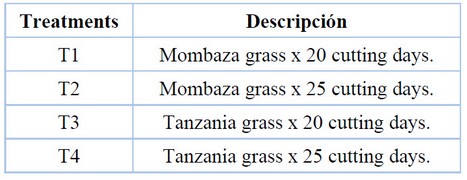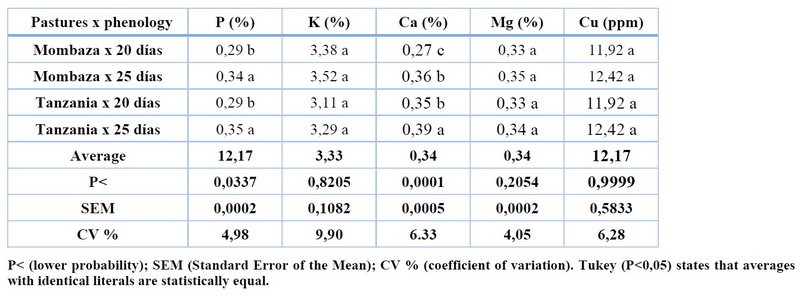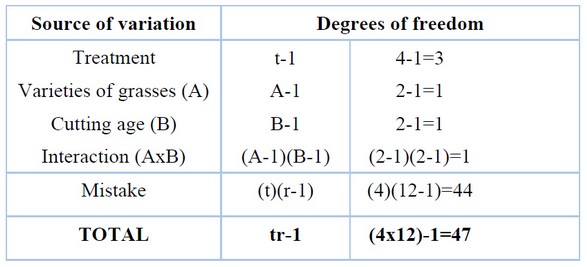2023.08.03.56
Files > Volume 8 > Vol 8 No 3 2023
Mineral profile in Panicum maximum cv Mombaza and Tanzania pastures at two regrowth ages
Manuel de Jesús Jumbo Romero 1 , Pedro Eduardo Nivela Morante 2*
, Pedro Eduardo Nivela Morante 2* , Álvarez Mendoza Jeisson Francisco 3
, Álvarez Mendoza Jeisson Francisco 3 , Esmeralda Barberan Diego Geovanny 4
, Esmeralda Barberan Diego Geovanny 4 , Zoila Rosario García Baque 5
, Zoila Rosario García Baque 5 , Tania Isabel Loor Arauz 6
, Tania Isabel Loor Arauz 6 .
.
1 Universidad Laica Eloy Alfaro de Manabí 1; [email protected]
2 Universidad Laica Eloy Alfaro de Manabí 2; [email protected]
3 Universidad Laica Eloy Alfaro de Manabí 3; [email protected]
4 Universidad Laica Eloy Alfaro de Manabí 4; [email protected]
5 Universidad Laica Eloy Alfaro de Manabí 5; [email protected]
6 Universidad Laica Eloy Alfaro de Manabí 8; [email protected]
* Correspondence: [email protected]; Tel.: (+593 998426187)
Available from: http://dx.doi.org/10.21931/RB/2023.08.03.56
ABSTRACT
This research was carried out in the Cattle Line Livestock Program, properties of the Río Suma experimental farm of the agricultural engineering career of the Laica Eloy Alfaro de Manabí University, in the El Carmen canton, Manabí province, located at Km 30 of the Santo Domingo - Chone road, right margin, between the coordinates of 0° 15' S and 79° 26' W. This study aimed to evaluate the effect of two varieties of pastures at two cut-off ages in mineral content. A completely random design with a 2 x 2 factorial arrangement was used. A total of 4 treatments were used, distributed in 12 repetitions. The statistical software INFOSTAT was used to process the information. The factors under study were varieties of pastures (Mombaza and Tanzania) and age of cutting or regrowth (20 and 25 days), and the variables under study Content of Phosphorus (P), Potassium (K), Calcium (Ca), Magnesium (Mg) and Copper (Cu). The Mombasa grass variety reaches a higher content of K and Mg, and the Tanzania grass contains a higher amount of Ca. The cut or regrowth age of 20 days obtains a more significant amount of Cu; at 25 days, it is possible to fix a more significant amount of P, Ca and Mg. The interactions between Mombaza x 25 days and Tanzania x 25 days reached a higher P content, and Tanzania x 25 days fixed a more significant amount of Ca.
Keywords: content; minerals; pastures
INTRODUCTION
One of the factors that determine the success of livestock is related to the quality and quantity of available forage, an aspect that, in tropical regions, constitutes a weakness in periods of water scarcity, in which the quality and amount of available forage decreases; which leads to weight loss and decreased production as a consequence of reduced forage consumption.1 Currently, the livestock sector must produce more efficiently to be competitive in the market and especially to meet the increasing demand for protein sources such as meat by the human population.2 In the tropical region, one of the main limitations in feeding bovine cattle is covering the mineral requirements through the forages supplied. Its deficiency is manifested by clinical signs in animals subjected to grazing, such as bristly hair and low fertility, which suggests mineral deficiency or imbalance. These conditions require attention to deficiency or undernutrition so that grazing bovines' productive and reproductive performance is not affected and, consequently, the producer's economy.3 Tropical grasses present fluctuations in their nutritional value throughout the year, decreasing their quality, especially in the dry season, producing a deficient animal response and, consequently, deficient productive and reproductive systems.4 The highest crude protein content was obtained with a cut-off frequency of 30 days. In the same way, the neutral detergent fiber and the acid detergent fiber will increase with the more significant time and height of the meadow.5 Deficiencies were diagnosed in the grass of P, Cu and Zn. The concentrations of these minerals differ between the two periods the weather of the year.6 On the other hand, Guinea grass (Panicum maximum) cv. Tanzania is a perennial grass with good agronomic and zootechnical characteristics; it presents high dry matter yields, good nutritional quality and excellent acceptance by cattle. It also adapts to soils of medium fertility and is resistant to drought.7 Mombasa grass is a cultivar of Panicum maximum Jacq. Due to their high biomass production capacity, species are being introduced as an option to improve the productivity of tropical grasslands. However, the traditional management and the lack of individual recommendations for this species need to have technologies for its optimization.8,9 Research in Mombaza grass with the use of zinc metallosate positively influenced leaf weight (5,40 g), stem weight (4,76 g), leaf length (55,39 cm), biomass (3369,76 DM kg ha-1) and dry matter (30,03%), increasing its content even when 2 L ha-1 of zinc metallosate was added at 28 and 42 days of harvest.10 These innovations are necessary to improve the agronomic response of Panicum spp, initiating a change in livestock production systems. Still, generating information and results on their mineral content is necessary. Macro and micro minerals are essential to ensure the life and productivity of all species; despite their importance, few efforts have been made to know and manipulate their presence in the forages administered in cattle production systems in Ecuador. The literature suggests that the results of the mineral content of the Tanzania and Mombaza pastures obtained were taken from the average of the percentage (%) of the macrominerals of phosphorus (P): 0,13 and 0,08; calcium (Ca): 0,25 and 0,43; potassium (K): 2,05 and 1,51; magnesium (Mg): 0,03 and 0,02; sodium (Na): 0,10 and 0,07; chlorine (Cl): 0,05 and 0,07; also in parts per million (ppm) the trace minerals iron (Fe): 204 and 244; manganese (Mn): 42 and 30; zinc (Zn): 16 and 18; and copper (Cu): 3 and 5, respectively.11 The analyzes of the reed (Paspalum notatum), humidicola (Brachiaria humidicola), insurgent (Brachiaria brizantha) and mulatto (Brachiaria hybrid) grasses CIAT 36061 reported the following results in Cu: 6,65; 5,62; 6,35 and 6,09 mg/kg-1, Iron (Fe): 267, 301, 254 and 2 65 mg/kg-1, Zinc (Zn): 37, 32, 37 and 40 mg/kg-1, Ca: 0,35; 0,33; 0,37 and 0,37 %, Mg: 0,26; 0,26; 0,28 and 0,27 %, Sodium (Na): 0,14; 0,11; 0,13 and 0,13 %; K: 1,57; 1,95; 1,51 and 1,60 % and P: 0,19; 0,22; 0,18 and 0,20 %, respectively.12 It is essential to know the mineral content from pastures as a food source for the animal since this determines if they cover their requirements or if it is necessary to supplement and its amount.13 El Panicum maximum alcanzó en contenido de fósforo de 0,16; 0,19 y 0,23 % y calcio de 0,80; 0,29 y 0,14 % en las épocas inicio de lluvias, lluviosa y seca, respectivamente.14
MATERIALS AND METHODS
This research was carried out in the Livestock Cattle Program, properties of the Río Suma experimental farm of the agricultural engineering career of the Universidad Laica Eloy Alfaro de Manabí, in the canton El Carmen, province of Manabí, located at Km 30 of the Santo Domingo-Chone road, right margin, between the coordinates of 0° 15' S and 79° 26' W. The pasture samples were analyzed in the Agrolab laboratory in Santo Domingo, Ecuador. The statistical software INFOSTAT (2008 version) was used to process the information.15 A completely randomized design (CRD) was used with a 2 x 2 factorial arrangement. A total of 4 treatments with 12 repetitions were used. (Table 1).
RESULTS
Mineral Content
Variety effect
The Variety effect (Table 2) on the contents of Potassium (K), Calcium (Ca) and Magnesium presented statistical differences (p<0.05). I stood out in K and Mg the Mombaza grass with 3,45 and 0,34 %, respectively. On the other hand, the Tanzania grass reached the highest Ca content with 0,37 %.
Phenology effect
The phenology effect (Table 3) on the Phosphorus (P), Calcium (Ca), Magnesium (Mg) and Copper (Cu) contents presented statistical differences (p<0.05). They stood out in P, Ca and Mg, the cut-off age of 25 days with 0,34, 0.37 and 0,35%, respectively. On the other hand, the cutting age at 20 days reached the highest Cu content with 11,92 ppm.
Pasture x phenology effect
The interaction of the pasture x phenology effects (Table 4) on the Phosphorus (P) and Calcium (Ca) contents showed statistical differences (p<0,05). They highlighted in P the interactions Mombaza x 25 days and Tanzania x 25 days with 0,34 and 0,35 %, respectively. On the other hand, in Ca, the interaction Tanzania x 25 days with 0,39 % stood out.

Table 1. Description of treatments used for the mineral profile.

Table 2. Grass variety effect on mineral content.

Table 3. Effect of cutting or regrowth age on mineral content.

Table 4. Interaction effect between variety x cutting age or regrowth effect on mineral content.
Formatting of Mathematical Components

Table 5. Description of the analysis of variance scheme for mineral content.
DISCUSSION
The mineral content results were obtained from the macrominerals' average percentage (%). In the Mombasa grass, it was Potassium (K) at 1.51 % and Magnesium (Mg): at 0.02 % and in the Tanzania grass, the calcium content was 0.25 %.10 This shows that the results achieved in our research were superior in the same elements.
The results of the reed (Paspalum notatum), humidicola (Brachiaria humidicola), rebel (Brachiaria brizantha) and mulatto (Brachiaria hybrid) grasses CIAT 36061 reported the following results in Cu: 6,65; 5,62; 6,35 and 6,09 mg/kg-1, Ca: 0,35; 0,33; 0.37 and 0,37 %, Mg: 0,26; 0,26; 0,28 and 0.27 % and P: 0,19; 0,22; 0,18 and 0,20 %, respectively.11 We can highlight the relevance of our results in the cut-off age effect since at 25 days, we report P (0,34 %), Ca (0,37 %) and Mg (0,35 %) and at 20 days Cu (11,92 ppm). Corroborating the same superiority in P, the interactions Mombaza x 25 days and Tanzania x 25 days with 0,34 and 0,35 %, respectively. In addition, the interaction Tanzania x 25 days with 0,39 % stood out in Ca.
CONCLUSIONS
The Mombasa grass variety reaches a higher content of K and Mg, and the Tanzania grass contains a higher amount of Ca. The cut or regrowth age of 20 days obtains a more significant amount of Cu; at 25 days, it is possible to fix a more significant amount of P, Ca and Mg. The interactions between Mombaza x 25 days and Tanzania x 25 days reached a higher P content, and Tanzania x 25 days fixed a more significant amount of Ca.
Supplementary Materials: There is no record
Author Contributions:
"Conceptualization, Jumbo. Manuel and Nivela Pedro.; Methodology, Jumbo. Manuel and Nivela. Pedro.; software, García. Rosario: validation, Jumbo. Manuel. Nivela. Pedro and García. Rosario; formal analysis, Alvarez. Jeisson.; investigation, Jumbo. Manuel and Nivela. Pedro; resources, Esmeralda. Diego.; data curation, Jumbo. Manuel.; writing—original draft preparation, Jumbo. Manuel and Tania Loor; writing—review and editing, Nivela. Pedro.; visualization, Esmeralda. Diego.; supervision, Alvarez. Jeisson.; project administration, García. Rosario.; funding acquisition, Jumbo. Manuel.
Informed Consent Statement: Not applicable.
Data Availability Statement: Not applicable.
Acknowledgments: Not appropriate.
Conflicts of Interest: The authors declare no conflict of interest.
REFERENCES
1. Villalobos. C. Gonzáles. E.; Ortega. J. Técnicas para estimar la degradación de proteína y materia orgánica en el rumen y su importancia en rumiantes en pastoreo. Téc Pec en Méx 2000. Vol. 38, núm. 2, 119-134.
2. La O. O.; González. H.; Orozco. A.; Castillo. Y.; Ruiz. O.; Estrada. A.; Ríos. F.; Gutiérrez. E.; Bernal. H.; Valenciaga. D.; Castro. B; Hernández. Y. Composición química, degradabilidad ruminal in situ y digestibilidad in vitro de ecotipos de Tithonia diversifolia de interés para la alimentación de rumiantes. Revi Cub de Cien Agrí 2012. Tomo 46, Número 1, 47-53.
3. Depablos. L.; Godoy. S.; Chicco. C.; Ordoñez. J. Nutrición mineral en sistemas ganaderos de las sabanas centrales de Venezuela. Zoot Tropi, 2009. 27(1), 27-38.
4. Garmendia. J. Suplementación estratégica en la reproducción de vacas de doble propósito. En: T. Clavero (Ed.). Tropical. Centro de Transferencia de Tecnología en Pastos y Forrajes: Maracaibo, Venezuela. 1998; 43-52 pp.
5. Schnellmann. L.; Oscar. J.; Bernardis. A.; Martínez. J.; Castillo. S.; Limas. A. Cutting frequency and height on the quality of Megathyrsus maximus (cv. Gatton panic). Cien y Tecn Agro 2020. 21(3), 1-11.
6. Balarezo. L.; García. L.; Noval. E.; Benavides. H.; Mora. S.; Vargas. S. Contenido mineral en suelo y pastos en rebaños bovinos lecheros de la región andina de Ecuador. Rev Cen Agrí 2017. Vol.44, No.3, 56-64.
7. Joaquin. B.; Joaquin. S.; Hernandez. A.; Perez. J. Efecto de la fertilización nitrogenada sobre el rendimiento y calidad de semilla de pasto guinea. Téc Pecu Méx 2009; 47 (1), 69-78.
8. Ramírez. O.; Hernandez. A.; Carneiro. S.; Perez. J.; Jacaúna. S.; Castro. R.; Enríquez, J. Características morfogenéticas y su influencia en el rendimiento del pasto mombaza, cosechado a diferentes intervalos de corte. Trop and Subtrop Agroec 2010, 12, 303 – 311.
9. Macías. D.; Vargas. P.; Solórzano. M.; Mendoza. F.; Intriago. F. Evaluación agroproductiva del pasto Panicum maximum CV. mombaza en el cantón El Carmen, Manabí-Ecuador. Rev Espamc 2019, Volumen 10 (2), 78-84.
10. Nivela. P.; Avellaneda. J.; Jumbo. M.; Morante. L.; Lazo. Y.; Aragundi. J. Metalosato de zinc en respuesta agronómica y composición química del pasto mombaza en la amazonía ecuatoriana. Cien y Tecn 2017. 10 (2), 47-52.
11. Cabrera. E.; Sosa. E.; Castellanos. A.; Gutiérrez. Á.; Ramírez. J. Comparación de la concentración mineral en forrajes y suelos de zonas ganaderas del estado de Quintana Roo, México. Vet Méx 2009. 40(2), 167-179.
12. Muñoz. J.; Huerta. M.; Rangel. R.; Lara. A.; De la Rosa. J. Evaluación mineral de forrajes del trópico húmedo mexicano. Trop and Subt Agro 2014. 17 (2), 285-287.
13. Herrera. R.; Fortes. D.; García. M.; Cruz. A.; Romero. A. Estudio de la composición mineral en variedades de Pennisetum purpureum. Rev Cub de Cie Agrí 2008, 42(4), 395-401.
14. Núñez. J.; Ñaupari. J.; Flores. E. Nutritional behavior and feeding profile of dairy production in cultivated pastures (Panicum maximum Jacq). Rev Inv Vet Perú 2019; 30(1): 178-192
15. Di Rienzo. J.; Casanoves. F.; Balzarini. M.; Gonzalez. L.; Tablada. M.; Robledo. C. InfoStat, versión 2008. Grupo InfoStat, FCA, Universidad Nacional de Córdoba, Argentina. 2008.
Received: 25 June 2023/ Accepted: 26 August 2023 / Published:15 September 2023
Citation: Jumbo Romero M J , Nivela Morante P E, Álvarez Mendoza J F, Diego Geovanny E B, García BaqueZ R , Loor Arauz T I. Mineral profile in Panicum maximum cv Mombaza and Tanzania pastures at two regrowth ages. Revis Bionatura 2023;8 (3) 56. http://dx.doi.org/10.21931/RB/2023.08.03.56
